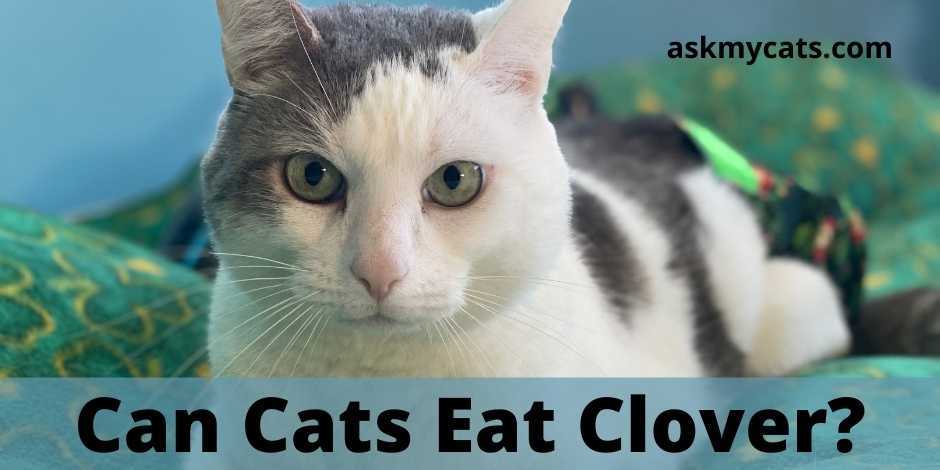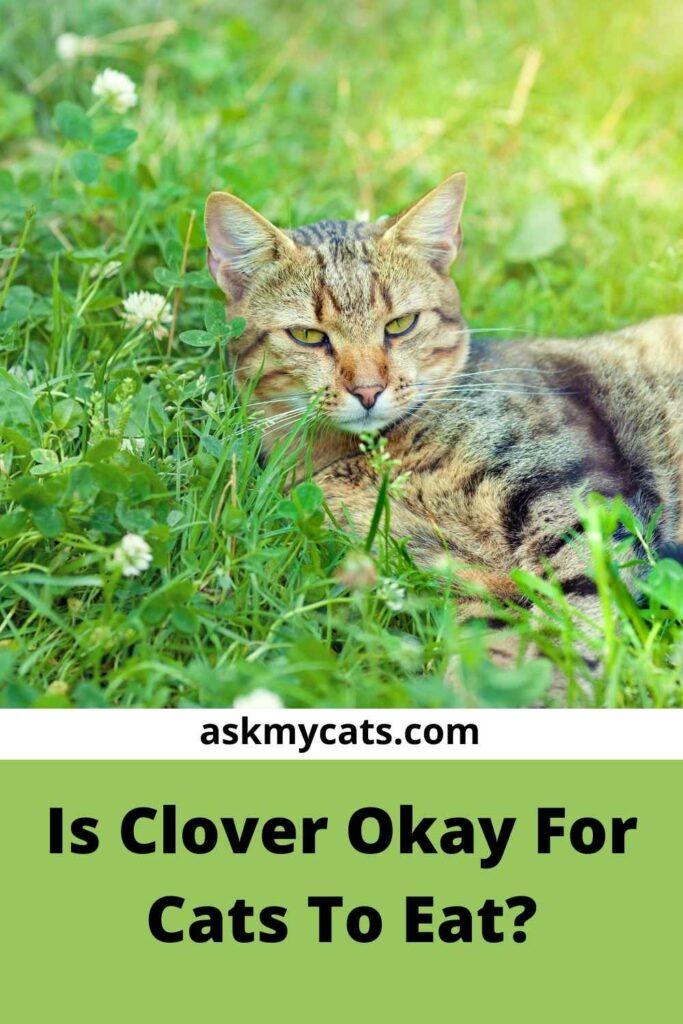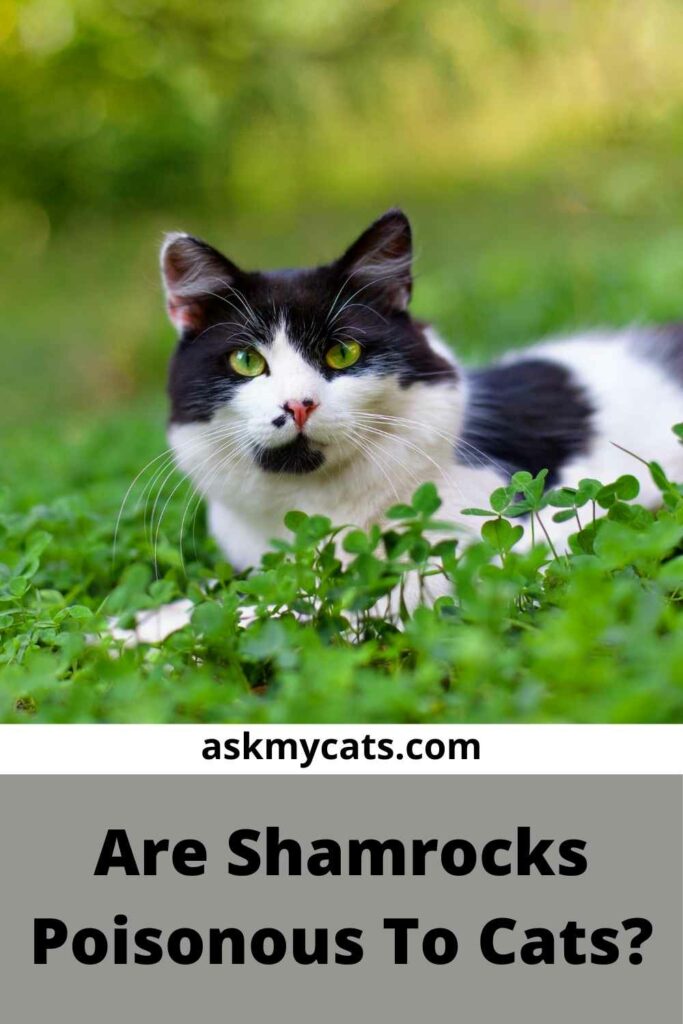Cats are curious creatures who will devour anything that catches their attention. Many seemingly innocuous plants can be dangerous to cats. Clover is one example of this.
Cats should not eat clover. Clover consumption has the potential to cause significant adverse effects in felines.
Toxicosis can occur if a cat consumes enough of this plant, however, it varies depending on the clover species. A few leaves should not cause toxicosis, but big amounts will induce vomiting, diarrhea, and bleeding problems in your cat.
The bitter taste of the Shamrock, Sorrel, or Oxalis plant deters dogs and cats from ingesting significant amounts. When consumed in big enough amounts by tiny animals, however, it can cause poisoning in dogs, cats, and even people.
If you want to learn more about clovers, their varieties and their effects on cats, keep reading!


Give Your Cat the Perfect Day
Get the Free Ebook!
Is Clover Okay For Cats To Eat?

No, cats should not eat clovers. Cats are poisoned by all portions of the clover plant, which contain soluble calcium oxalates.
When swallowed, they are spike-like molecules that embed themselves. A cat is unlikely to consume a considerable amount of the plant since it is bitter and unappealing.
If your cat ingests a good luck plant, however, you should seek veterinarian treatment and guidance due to the risk of kidney injury.
Because soluble calcium oxalate does not embed itself in the upper gastrointestinal system and does not generate symptoms in your cat until the oxalate components reach the kidneys, signs of good luck plant poisoning do not occur immediately away.
When poisoning symptoms develop, they include:
- Agitation
- Pain
- Appetite loss.
- Diarrhea
- Vomiting
- Lethargy
- Weakness
- Tremors
- Urine with blood
- Changes in the amount of water consumed and the amount of urine produced
- Failure of the kidneys
Are Shamrocks Poisonous To Cats?

Shamrocks, also known as wood sorrel or clover, are members of the Oxalis genus. It contains a number of annual and perennial plants with trifoliate leaves and exquisite flowers.
Calcium oxalate crystals found in Oxalis plants can cause gastrointestinal issues and kidney damage if ingested in high amounts. Because of the oxalates, the plants have an acidic or tart flavour. This has earned them the nickname “sour grass.”
Calcium oxalate crystals may be found in all sections of the plant, which are detrimental to a cat’s health.
Early detection of shamrock poisoning in cats will allow you to get them to a veterinarian as soon as possible. This is essential in saving your feline’s life.
Shamrock produces tremors and salivation in animals, according to the American Society for the Prevention of Cruelty to Animals, but it can also cause vomiting and other gastrointestinal issues.
If you notice your feline nibbling on shamrock leaves or find shamrocks in his vomit, contact your veterinarian. Shamrock poisoning in cats is rarely serious or deadly, but if a significant amount of the plant is ingested, it can cause renal failure.
Why Do Cats Eat Shamrock Plants?
Shamrock plants are commonly offered as a decoration or gift around St. Patrick’s Day. These green or purple three-leaved plants, which are said to bring good luck, however, aren’t so lucky for curious pets.
Cats are inquisitive animals who will devour anything that catches their attention. A shamrock plant (Oxalis regnellii), sometimes called wood sorrel, can poison your cat if eaten.
A shamrock plant, like any other toxic houseplant, should be maintained out of reach of pets or replaced with a pet-friendly substitute.
The shamrock plant’s leaves contain soluble oxalate salts. Soluble oxalate salts bind to calcium in the body and hinder it from being absorbed by the pet. Calcium levels in the blood decline as a result of this.
The soluble oxalate salts in shamrock plants bind with calcium to create kidney stones when consumed over a lengthy period of time. Shamrock plants can induce acute renal failure if consumed in high quantities over a short period of time.
What Parts Of The Shamrock Plant Are Poisonous Or Toxic To Cats?
It’s crucial to note that because shamrock plant contains oxalic acid, all portions of the plant are poisonous.
Fortunately, this component also gives them an extremely sour taste, which makes them unappealing to pets and cattle. Even so, an inquisitive or bored pet could opt to go on a wild wander.
The tubers from which these plants develop are also poisonous, in addition to the leaves. Because the roots are shallow, a digging pet will get into contact with them fast and readily.
It’s also crucial to remember that your pet would have to eat a significant amount of the plant or its tubers to become poisonous.
What Should I Do If My Cat Eats A Shamrock Plant?
Shamrock poisoning is uncommon, and a pet with healthy kidneys can usually pass tiny quantities of soluble oxalate salts.
Soluble oxalate salts, even in tiny amounts, can irritate the stomach lining, causing drooling, vomiting, and diarrhea. Tremors, tiredness, changes in urination and water consumption, and bloody urine are all signs to look out for.
If your pet ate a shamrock plant, call your veterinarian straight away, even if they just ate a little quantity and aren’t showing any symptoms yet. The amount of time it takes for your pet to become hazardous varies depending on its size and underlying problems.
How Do I Prevent My Cat From Eating Shamrock?

Cats are naturally inquisitive creatures who are difficult to control. It’s never easy to keep a cat away from hazardous plants, but it’s especially tough with weedy, quickly growing plants like oxalis.
Outdoor cats are especially vulnerable to shamrock poisoning because they explore beyond their local surroundings and might wander into fields or yards where shamrock plants abound.
Potted oxalis or decorative shamrock plants are simpler to keep out of the reach of cats.
Place potted shamrocks in a bright, south-facing window on a high shelf or in a hanging planter where they will get enough light to thrive. Alternatively, keep the pots out of the way of cats.
Place the plant inside a wire birdcage as another alternative. Drinking the water runoff from the catch basin beneath the pot is a frequently ignored cause of unintentional poisoning in cats. After watering shamrock plants, always drain away any excess water.
How Do I Remove Shamrocks From My Garden?
Shamrock plants grow so fast that they’re sometimes mistaken for weeds, especially if they’re growing in a lawn or manicured area. When the earth is wet and the unwanted shamrock plants are young, they can be physically plucked off.
Because these stubborn plants may spread via their roots, it is critical to destroy the entire plant. Shamrocks also spread quickly through seed dispersal.
Because the seeds require light to germinate, a thin layer of mulch or compost put to the plants might prevent them from germinating.
Herbicides are another option for shamrock management and removal in the garden. To remove oxalis in landscaping beds, we recommend using nonselective herbicides such as glyphosate, as well as a pre-emergent or post-emergent herbicide if oxalis is present in a lawn.
Always examine the safety of any chemical poison used in areas where dogs and children play, and always apply it according to the manufacturer’s instructions.
Is Clover Poisonous To Cats?
Cats can be poisoned by clover. If you have curious cats in your house, we recommend avoiding this plant.
Good Luck Plant, Sorrel, Purple Shamrock, and Love Plant are all names for the Oxalis species, or shamrock plant. This plant might harm your kidneys if you eat too much of it.
Is Lawn Clover Safe For Cats?
The bitter taste of grass clover frequently deters cats from eating excessive amounts of it. When consumed in big enough amounts by tiny animals, however, it can cause poisoning in dogs, cats, and even people.
All sections of the plant contain soluble calcium oxalates in different degrees. When soluble oxalate salts are absorbed from the gastrointestinal system, they bond with calcium in the body, causing a calcium decline.
Ingestion of plants or fruit containing these soluble oxalate crystals might cause abrupt renal failure in rare cases. Drooling, vomiting, diarrhea, lethargy, weakness, tremors, bloody urine, and changes un thirst and urination are all symptoms of this form of poisoning.
Can Cats Have Red Clover?
The red clover is a blooming herbaceous plant that is native to Europe, Western Asia, and northwest Africa, and belongs to the bean family Fabaceae. In many other areas, it has been planted and naturalised.
Because red clover is high in estrogenic isoflavones, a little goes a long way. It may be utilised both on the outside and on the inside.
A pinch of dried red clover can be given to a cat as a preventive precaution when added to its daily food.
The red clover plant itself is not poisonous. The toxin linked to red clover poisoning, however, is slaframine, which is generated by the fungus Rhizoctonia leguminicola.
When there is a lot of humidity, a drought, or a lot of red clover, this fungus develops on it.
Is White Clover Bad For Cats?
The white clover, also known as Dutch clover, Ladino clover, or simply Ladino, is a perennial herbaceous plant of the Fabaceae bean family.
It’s a perennial herbaceous plant. It’s a low-growing shrub with heads of white blooms, typically with a tint of pink or cream that develops as the plant ages.
Some wild strains of White Clover can be moderately poisonous if consumed in large quantities by cats. This is due to the presence of a glycoside in its leaves that transforms to prussic acid.
However, cultivated White Clover strains lacking this glycoside have been produced. White Clover and other clovers have a great ecological importance to animals in general.
Are Clover Leaves Toxic To Cats?
Clover leaves are poisonous to cats. If you have curious cats in your house, we recommend avoiding this plant.
This plant might harm your feline’s kidneys if she eats too much of it.
Frequently Asked Questions
Is It Okay For Cats To Eat Clover?
No, cats should not eat clover. Cats can be poisoned by all components of the plant.
Is White Clover Toxic To Cats?
If consumed in high numbers, certain wild strains of White Clover can be moderately poisonous to felines.
Final Words
Shamrocks are universally associated with good fortune. However, if your cat eats these plants, they can be harmful to you.
If you have curious cats in your house, we recommend avoiding the clover plant. Good Luck Plant, Sorrel, Purple Shamrock, and Love Plant are all names for the Oxalis species, or shamrock plant.
This plant might harm your feline’s kidneys if she eats too much of it. Drooling, vomiting, diarrhoea, and a loss of appetite are all signs of Oxalis poisoning.
If you believe your pet has eaten this plant, contact your veterinarian right once.
Please drop down your queries regarding your feline friend in the comment section below. We will answer them soon!
